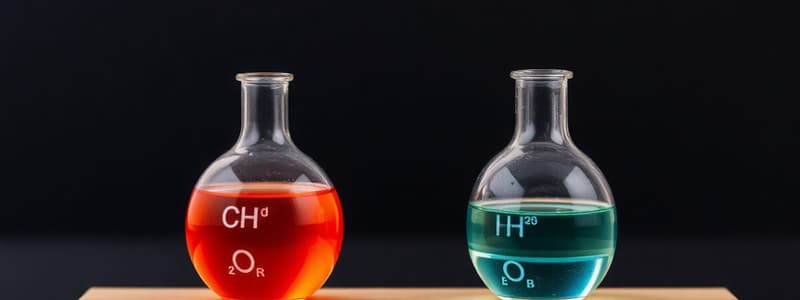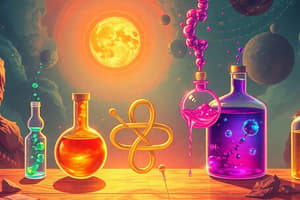Podcast
Questions and Answers
What condition must be met for a chemical system to be in dynamic equilibrium?
What condition must be met for a chemical system to be in dynamic equilibrium?
- The system must have only reactants present.
- The concentrations of reactants must be equal to the concentrations of products.
- The rates of the forward and reverse reactions must be equal. (correct)
- The reaction must proceed only in the forward direction.
In the ICE table, what does the '-X' signify?
In the ICE table, what does the '-X' signify?
- The change in concentration of reactants. (correct)
- The equilibrium constant of the reaction.
- The initial amount of reactants.
- The total concentration at equilibrium.
How is the equilibrium constant (Kc) calculated?
How is the equilibrium constant (Kc) calculated?
- The sum of the concentrations of products divided by the sum of the concentrations of reactants.
- The product of the concentrations of products raised to their stoichiometric coefficients, divided by reactants raised to theirs. (correct)
- The difference between reactant and product concentrations.
- The average concentrations of all reactants and products.
What does it indicate if Kc is much larger than 1?
What does it indicate if Kc is much larger than 1?
What occurs if the reaction quotient Q is greater than Kc?
What occurs if the reaction quotient Q is greater than Kc?
Which substances are excluded from the equilibrium constant expression Kc?
Which substances are excluded from the equilibrium constant expression Kc?
What is the role of stoichiometry in equilibrium calculations?
What is the role of stoichiometry in equilibrium calculations?
When using the ICE table, how do you calculate the equilibrium concentration?
When using the ICE table, how do you calculate the equilibrium concentration?
Which statement about the reaction quotient Q is false?
Which statement about the reaction quotient Q is false?
How do equilibrium calculations differ from unidirectional reactions?
How do equilibrium calculations differ from unidirectional reactions?
Flashcards
Chemical Equilibrium
Chemical Equilibrium
The point at which the rates of the forward and reverse reactions are equal, resulting in no net change in the concentrations of reactants and products. The system appears inactive, but reactions are still happening.
ICE table
ICE table
A table used to solve equilibrium calculations by organizing initial concentrations, changes, and equilibrium concentrations.
Equilibrium Constant (Kc)
Equilibrium Constant (Kc)
A constant that indicates the relative amounts of reactants and products at equilibrium for a particular reaction. It is calculated by dividing the product of product concentrations (raised to their stoichiometric coefficients) by the product of reactant concentrations.
Reaction Quotient (Q)
Reaction Quotient (Q)
Signup and view all the flashcards
Q vs. Kc
Q vs. Kc
Signup and view all the flashcards
Calculating Equilibrium Concentrations
Calculating Equilibrium Concentrations
Signup and view all the flashcards
Limiting Reactant
Limiting Reactant
Signup and view all the flashcards
Theoretical Yield
Theoretical Yield
Signup and view all the flashcards
Le Chatelier's Principle
Le Chatelier's Principle
Signup and view all the flashcards
Solids and Pure Liquids in Kc
Solids and Pure Liquids in Kc
Signup and view all the flashcards
Study Notes
Chemical Equilibrium
- Chemical reactions can proceed in both forward and reverse directions.
- When the rates of the forward and reverse reactions are equal, the system is in a state of dynamic equilibrium.
- While chemical reactions occur in equilibrium, the system appears inactive because the forward and reverse reactions happen at the same rate.
- Stoichiometry helps calculate the limiting reactant and the expected product yield in unidirectional reactions.
- Equilibrium calculations are more complex as they involve determining the concentration of each substance at equilibrium.
ICE Table
- The ICE (Initial, Change, Equilibrium) table helps organize and solve equilibrium calculations.
- Fill the table with the initial amount of each substance.
- Use -X to represent the change in concentration for reactants and +X for products.
- The coefficients in the balanced equation are used to determine the change in concentration.
- The equilibrium concentration is the sum of the initial concentration and the change.
Equilibrium Constant (Kc)
- Each equilibrium reaction has a specific equilibrium constant (Kc).
- Kc is calculated by multiplying the concentrations of products, each raised to their stoichiometric coefficient, and dividing by the product of the concentrations of reactants, each raised to their stoichiometric coefficient.
- Kc indicates the relative amounts of products and reactants at equilibrium.
- If Kc is much larger than 1, the products predominate at equilibrium.
- If Kc is much smaller than 1, the reactants dominate at equilibrium.
- Solids and pure liquids are not included in the Kc expression.
Reaction Quotient (Q)
- Q can be calculated by substituting non-equilibrium concentrations into the Kc expression.
- If Q is less than Kc, the reaction will shift to the product side to reach equilibrium.
- If Q is greater than Kc, the reaction will shift to the reactant side to reach equilibrium.
- If Q is equal to Kc, the system is already at equilibrium.
Calculating Equilibrium Concentrations
- Using the ICE table and the Kc expression allows for the calculation of equilibrium concentrations.
- Substitute the equilibrium concentrations into the Kc expression and solve for X.
- The value of X can then be used to determine the equilibrium concentrations of all substances.
Studying That Suits You
Use AI to generate personalized quizzes and flashcards to suit your learning preferences.




